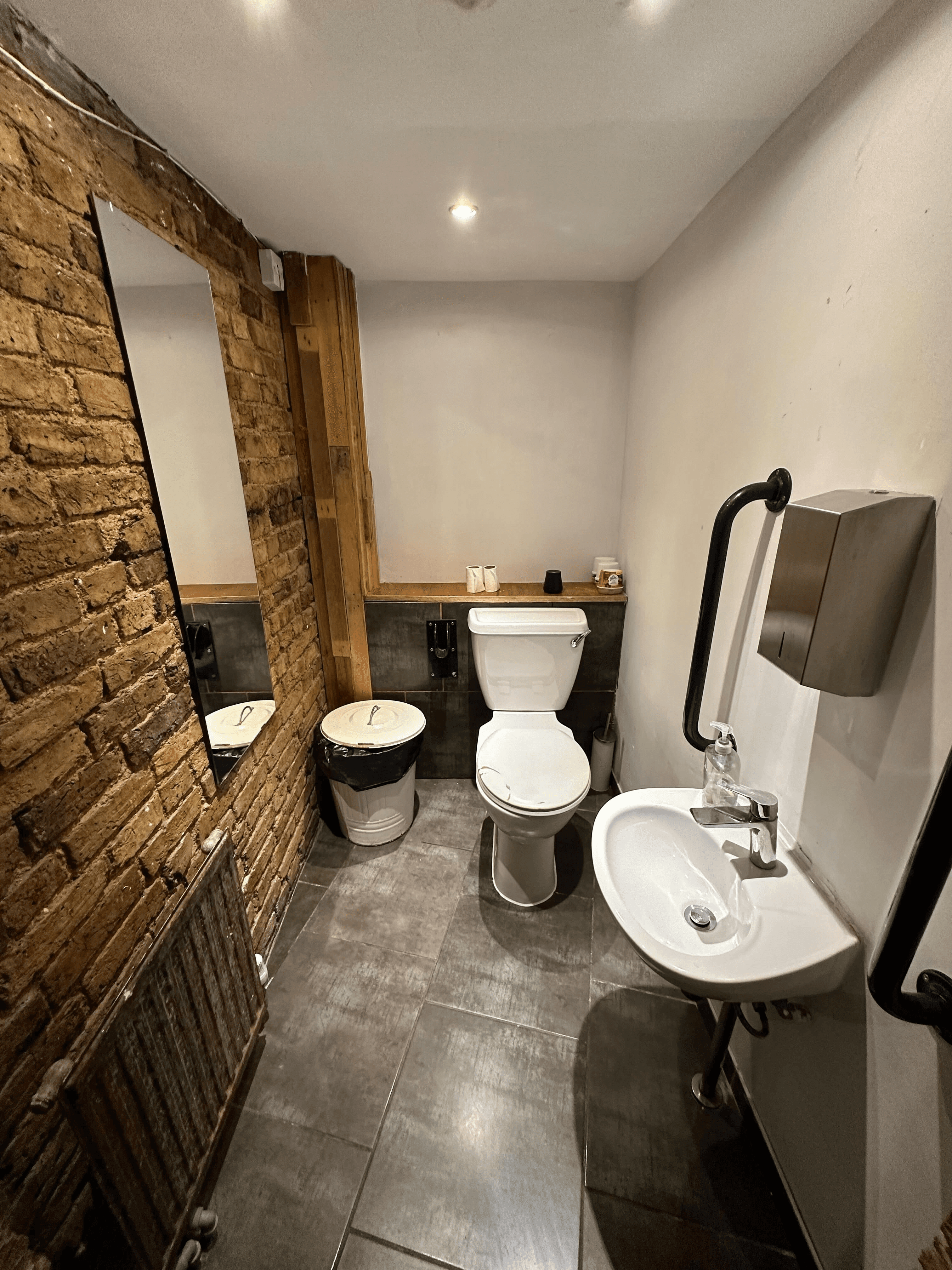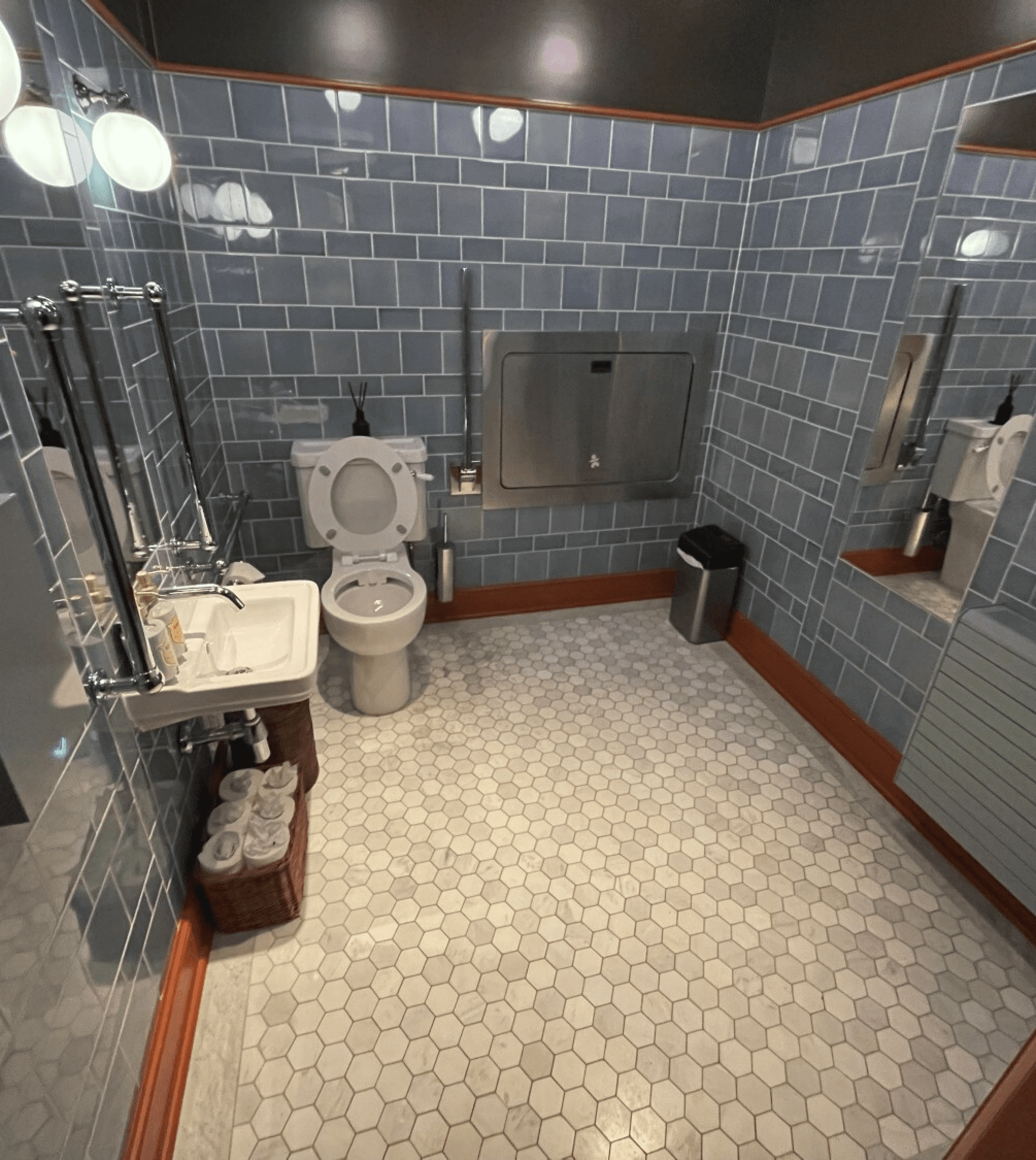Bathrooms
After entrances, bathrooms are arguably the most important area to tag. For many disabled people having easy access to the bathroom is essential for not only personal hygiene and continence, but peace of mind more broadly. That said, the type and accessibility features of bathrooms vary greatly between venues so it's particularly important to pay strong attention to detail when tagging a bathroom.
Type of bathrooms
Whilst there may be multiple bathrooms inside a venue, we ask users to tag only the most accessible bathroom available. These are as follows – in order from most to least accessible:
Wheelchair-Accessible Bathroom: To be wheelchair-accessible, the bathroom must be step-free. It must also have a wide enough doorway for a wheelchair user to enter, and the room itself must be large enough for a wheelchair user to manoeuvre around inside. It may also be equipped with additional features such as grab rails and a lower sink – but this is not necessarily the case. Sometimes they will require staff approval or a Radar Key to access them too.
Non-Wheelchair-Accessible Bathroom: This refers to a bathroom that is not step-free and/or has insufficient space for a wheelchair to manoeuvre around inside. These bathrooms are often characterised by narrow cubicles.
No Bathroom on Site: If a venue does not have any bathroom facilities on-site, you should still tag this information to let users know that they may need to make alternative arrangements if they visit.
Gender-Specific Bathrooms
Tagging whether a bathroom is gender-specific or gender-neutral helps our users to find facilities they are comfortable using in public. This is particularly important for families, and users with specific health or accessibility needs. The two tags available are:
Gender-Specific Bathrooms: These are bathrooms with a visible designation for use by either Men or Women. It's important to note the presence of amenities such as baby changing facilities, which might sometimes be located in a bathroom designated for a specific gender.
Gender-Neutral Bathrooms: These are bathrooms with either:
a visible designation for use by people of any gender; or
no visible designation for use by any particular gender (eg. bathrooms with a wheelchair symbol only). These bathrooms typically feature individual stalls and may have shared washing areas.
Changing Places Toilet
A Changing Places Toilet is a specialised, larger bathroom designed to provide a specific set of accommodations. These are not simply bathrooms with baby change facilities.
Changing Places Toilets are typically indicated by a specific sign and includes unique features such as a hoist, adult-sized changing bench, curtain or screen. The design ensures there is enough room to accommodate a wheelchair user and two carers, facilitating easy manoeuvring within the space.
You can read more about Changing Places Toilets here.
Bathroom Sizes
When assessing the space of a bathroom, consider the needs of people who may require more space:
Small, Cramped Bathroom: Just enough space to fit a wheelchair but might be tight for turning or moving around.
Regular, Sized Bathroom: A standard size wheelchair-accessible bathroom, offering adequate space for a wheelchair to fit in and move around comfortably.
Large, Spacious Bathroom: Suitable for a wheelchair user accompanied by a carer or companion. There is enough space for the wheelchair user to manoeuvre and to receive assistance as required.
For non-accessible bathrooms or cubicles, use your judgment to assess the space between yourself and the door.
Radar Keys
Radar Keys are special keys that provide access to locked, wheelchair-accessible toilets across the UK. Radar Keys are provided as part of a dedicated scheme that disabled people can join for a fee. If you need access to a toilet but do not have a Radar Key, ask the venue to unlock the bathroom. They should have a key available on-site.
Pathways and Access
When you're on your way to the bathroom, it's good to observe and document the pathways along the way. This information is valuable for users who need to understand the journey to the bathroom. Pay attention to details like:
Pathway Width: Tag whether the paths are narrow or wide. Wide pathways are generally more accessible, especially for wheelchair users or those with mobility aids.
Steps and Ramps: Note the presence of any steps or ramps along the path. Describe their condition, steepness, and whether there are handrails or other support features present.
Doors: Tag any doors that you need to pass through to reach the bathroom. Note if these doors are manually operated, automatic, or otherwise require assistance to open.
Taking pictures of these features is particularly helpful. When tagging, include clear, wide-angle images that showcase the bathroom's overall size and layout. This allows users to see the bathroom before they arrive and determine if the space meets their needs, providing much greater peace of mind than tags alone.


